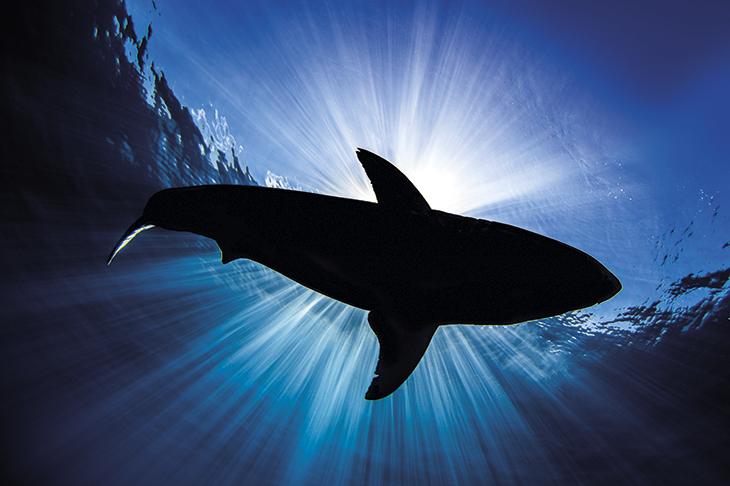Such a sublime, terrible beauty, the shark. Glidingly filled with our awe, as if those glassy eyes marked us out as a bite-sized snack from the start. Evolutionarily pre-lapsarian — they’ve been around for 450 million years — sharks are wreathed in a symbolic cruelty, theirs and ours. In one of the most vivid scenes in Moby-Dick, the whalers slice into sharks attempting to prey upon their prized whale catch; yet even as the fishes’ entrails spill out, the dying animals are so ferocious that they eat their own innards. It’s a terrifying, almost Jungian image of consumption that seems to echo the reality of their fate.
William McKeever’s book seeks to dispel these fearful dreams. Taking four species of shark — great white, mako, tiger and hammerhead — he starts with the first emperor of the sea, the great white. Prowling the east coast of the USA, this ultimate predator begat its own modern myth in 1916, when a spate of shark attacks on bathers on the New Jersey shores set in motion the prejudiced story that would culminate in Peter Benchley’s Jaws. But, as McKeever shows, the 21st century would reinvent this narrative in the same waters in which Benchley’s book was set.
With the end of a legal cull of grey seals off Cape Cod in 1972, their expanding population has drawn in great whites so close to the shore that friends of mine there have seen the vast bodies of the sharks (a fully-grown great white can reach the same length and weight of an adult giraffe) beaching themselves in search of their prey. Sadly, in the past couple of years, their victims have included humans, one of whom died last year. A mobile phone snap I saw of another surfer, who survived, showed his thighs bitten so deep that they gaped open as though great wedges of Edam cheese had been gouged out of them.
A hundred million sharks die at human hands each year, many to supply shark fin soup
It was in these New England waters, too, that McKeever first gained his love and fear of sharks as a child. Now a conservationist and film-maker, his book pays tribute to the animals in affectionate but coolly controlled prose.
In his description, the great white has the glamour of an expensive sports car, with its bizarre, flattened yet rough-surfaced and interlocking denticles, pseudo-scales (they feel like sandpaper) providing the hydro-dynamic slide that allows the creature to dive better than almost any other marine species. Powered by its muscular tail and twisting pectoral fins, it glides downward as if it were a futuristic robotic invention, an aquatic terminator.
It’s a notion accentuated by the fact that scientists now know so much more about these animals, due to modern tagging techniques that turn the shark into a drone of itself. Mindless? Not at all. The great white’s Y-shaped brain, superior to all fishes, is equipped with acute scent organs that locate its prey with laser accuracy, while ‘a special vessel arrangement near their eyes warms them and the brain for faster processing’.
All this glory is set against something truly awful: the fate we mete out to these miracles of marine evolution. A hundred million sharks die at human hands each year, many to supply shark fin soup. The fins are sliced off living sharks, leaving them to drown — sharks must be forever moving to ensure the flow of oxygen through their gills. Others perish in the barbaric sport of ‘shark tournaments’, of which there are 70 such events organised annually on America’s east coast. In his chapter on the mako, McKeever addresses this Hemingwayesque torture (the gung-ho author used to shoot the animals) in which a hunter can win a prize of up to $250,000, while the fish suffers an excruciating end.
It is an ongoing, surreal nightmare. A mako will ‘fight like a prize fighter and have the heart to fight to the death’. Landed on deck by so-called ‘sport’ fishermen, the creatures can wreak a dying revenge as they thrash enough to break the bones of their assailants. McKeever blows out of the water the assumption that fishes feel no pain. Pain is as much a survival warning sign for them as it is for us. He quotes Culum Brown, an Australian scientist: ‘It would be impossible for fish to survive as the cognitively and behaviourally complex animals they are without a capacity to feel pain.’
But in laying out his story so succinctly, McKeever demonstrates the more benevolent curiosity of our species. His hunt for facts, from the USA to Hawaii, South Africa and Cambodia, is more relentless than any trophy-seeker wanting a pair of jaws to hang on his wall. He discovers that the health of the Great Barrier Reef depends on the presence of tiger sharks. Australia’s most vulnerable marine environment relies on them to control ‘mid-level predators’, such as groupers and snappers, which, if left unchecked, deplete the parrot fish that eat coral-endangering micro-algae. McKeever compares the situation to the removal of wolves from Yellowstone Park, which allowed deer to proliferate, also with disastrous results.
Most eerie, because the most alien-looking of McKeever’s chosen sharks, is the hammerhead. I remember seeing one twist in the waters beneath me off the Azores, a shiver-inducing sight. McKeever explains that the ‘cephalofoil’ head enhances the animal’s vision, as well as allowing it to smell the water for the precise whereabouts of its prey. Such attributes suit the species to its specific food source, stingrays, whose barbs they disable by biting off their wings.
Our own ceaseless search for food is less well designed when it comes to the fate of the shark. Millions die as bycatch on the ill-regulated longlines of factory fishing fleets that can play out for 100 miles and catch more sharks than the tuna they are supposed to ensnare. Others are killed for their liver oil, cartilage and squalene, a fat used for moisturiser and lipstick.
Reaching beyond these depredations, Emperors of the Deep is a heartfelt tribute to the shark. When McKeever finally comes face to face with a great white, the monster of his childhood nightmares, his fear is gloriously transformed to awe, as he steals a glimpse of ‘a steadfast guardian of the world’s oceans’.






Comments